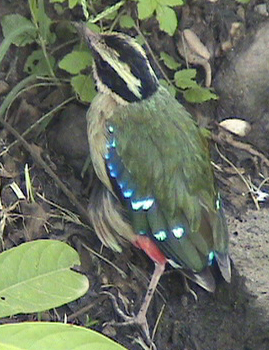Alternative name: Angolan Pitta
- Pitta angolensis
Identification
18 - 20cm.
- Black head with a broad buffish-ochre supercilium
- Bright green upperparts
- Sky-blue rump and tail-coverts
- Black tail
- Sky-blue and violet area near shoulder and wing-coverts
- Blackish flight-feathers, paler tips, white patch on primaries
- White throat with pink wash
- Deep buff breast and flanks, often with golden-green wash
- Scarlet belly and undertail-coverts
- Black bill
Sexes similar. Juveniles are much duller and browner than adults.
Similar species
Green-breasted Pitta has a green breast (not buff).
Distribution
Widespread throughout sub-Saharan Africa:
Western Africa: Guinea, Sierra Leone, Liberia, Ivory Coast, Ghana, Togo, Nigeria, Cameroon, Central African Republic, Equatorial Guinea, Gabon, Congo, Angola
Eastern Africa: Kenya, Uganda, Rwanda, Burundi, Tanzania, Zambia, Mozambique, Malawi
Southern Africa: Namibia, Zimbabwe, extreme north-eastern South Africa
Taxonomy
Subspecies[1]
- P. a. pulih:
- Sierra Leone and south-eastern Guinea to western Cameroon
- P. a. angolensis:
- P. a. longipennis:
- Intratropical migrant (south-eastern Zaire to eastern South Africa)
Habitat
Evergreen and semi-deciduous rainforest, thickets and swampy localities with dense undergrowth. Found in lowlands and hills up to 1000m.
Behaviour
Feeds on insects (termites, ants, beetles, caterpillars and grubs), snails, earthworms and milipedes.
Forages on the ground among leaf litter, often near ant and termite nests.
Breeding season differs through range. The domed nest is made of dead leaves, twigs, rootlets and tendrils. It's placed 2-8m above the ground in a thorny tree. Lays 3 eggs.
Population in western Africa largely sedentary, longipennis is an intratropical migrant.
References
- Clements, JF. 2010. The Clements Checklist of Birds of the World. 6th ed., with updates to December 2010. Ithaca: Cornell Univ. Press. ISBN 978-0801445019. Spreadsheet available at http://www.birds.cornell.edu/clementschecklist/Clements%206.5.xls/view
- Dickinson, EC, ed. 2003. The Howard and Moore Complete Checklist of the Birds of the World. 3rd ed., with updates to October 2008 (Corrigenda 8). Princeton: Princeton Univ. Press. ISBN 978-0691117010
- Gill, F and D Donsker (Eds). 2010. IOC World Bird Names (version 2.7). Available at http://www.worldbirdnames.org/.
- Del Hoyo, J, A Elliot, and D Christie, eds. 2003. Handbook of the Birds of the World. Volume 8: Broadbills to Tapaculos. Barcelona: Lynx Edicions. ISBN 978-8487334504
Recommended Citation
- BirdForum Opus contributors. (2024) African Pitta. In: BirdForum, the forum for wild birds and birding. Retrieved 1 September 2024 from https://www.birdforum.net/opus/African_Pitta
External Links
GSearch checked for 2020 platform.




